


Milk simply seeps out of the glands of the mother animal. But before you make your guesses, the milk teeth of the young don’t have any purpose nor has the mother nipples. The young are also fed in a way that no other animal does. The male will then insert his penis, which is hidden in his cloaca, into the female's cloaca for fertilization - this process can take up to 10 minutes, Thomas said.Īfter mating, the female will ignore all other mating attempts during that breeding season, and the male may go on to find other females to mate with. That said, the absence of teeth and a stomach is not the only unique thing about the platypus. To copulate, the male will climb partially on to the female's back, and curl his tail under her abdomen to bring their respective cloaca (waste and reproductive orifice) close together. 52 Inland, its distribution is not well known. They will also engage in other aquatic courtship activities, such as diving, rolling sideways together and swimming near each other, sometimes for a few days before finally mating. The platypus is semiaquatic, inhabiting small streams and rivers over an extensive range from the cold highlands of Tasmania and the Australian Alps to the tropical rainforests of coastal Queensland as far north as the base of the Cape York Peninsula. "They will then swim in a circle," Thomas said. Until that point, she may hang out in the same area and feeding pond as the male, but won't allow him to make physical contact with her.Īfter the female has decided to accept her potential mate, she will allow him to bite on her tail and she will respond by biting on his tail. Males will try to court females by biting on the female's tail, but the female will flee if she's not ready. Females don't appear to be picky with their choice of mates, and probably assume that the male in their area is the biggest and strongest, Thomas said, adding that the female in the Healesville Sanctuary's captive breeding program will court and mate with any male presented to her.Īdult platypus pairs engage in a courtship ritualthat lasts several weeks and takes place up to six weeks before mating occurs. Little is known about what drives sexual selection in platypuses.


 0 kommentar(er)
0 kommentar(er)
